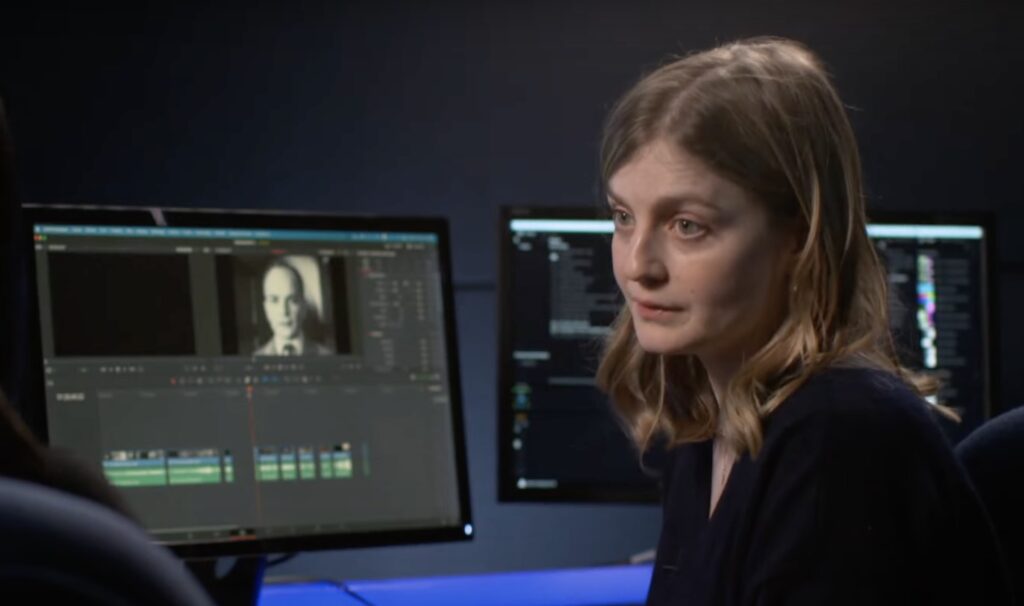After obtaining a Ph.D. in cinema studies and completing a post-doctorate in cinema and the neurosciences at the Università di Parma in Italy, Anna Kolesnikov joined Laboratoire CinéMédias as a post-doctoral researcher.

William Pedneault-Pouliot
At the intersection of the neurosciences and cinema studies, Anna Kolesnikov’s research has to date primarily explored “corporeal cognition in the audiovisual experience, the theory of Soviet montage and the perception of movement and of music”, she explains.
Her joining of these two disciplines is intrinsically tied to her research path since her master’s degree in the I/MA/C/S program at Université Sorbonne Nouvelle (Paris 3), a program of which the Université de Montréal is also a part. “I was doing something a bit strange at the time, meaning that I was trained in the neurosciences and cognitive sciences, but wanted to steer my work towards approaches based on the humanities”, she relates. This transition would take place by means of cinema studies, and more particularly through study of the theory and practice of the Russian filmmaker Sergei Eisenstein through the lens of the cognitive sciences.
This study topic led her to the Lab of Social Cognitive Neuroscience led by professor Vottorio Gallese at the Università di Parma in Italy, where from 2017 to 2021 she worked on a doctorate on the philological-literary, historical-philosophical and artistic sciences. While working on her dissertation she collaborated with a filmmaker and a composer to create short films inspired by Mikhail Kalatozov’s film The Cranes Are Flying (1957), and then measured the cognitive responses of viewers of these films using the “audiovisual gesture” model developed by Eisenstein.
Her goal was to carry out a project which joined the neurosciences with cinema studies using a “neuro-humanist” approach, meaning that she used “the two disciplines in an egalitarian rather than a reductionist manner, which involved using the methods of the humanities rather than simply using the arts or films as stimuli”. This unorthodox project enabled her to gain expertise in both disciplines at the same time.
Betwixt Continuity and Change at Laboratoire CinéMédias
Following her post-doctoral research at the Università di Parma, Kolesnikov moved to Montreal. This was when she joined Laboratoire CinéMédias, a decisive step in her career: “Apart from Parma and Montreal, there are not many research groups developing this neuro-cinema approach in a truly intersectoral manner. For me, it was an opportunity to do research on neuro-cinema, but from another perspective, by finding connections between montage and the brain. This enables me to return to theoretical frameworks after carrying out empirical work, which I find just as gratifying and important a part of the equation”.
Today Anna Kolesnikov is involved in the development of various projects within the laboratory. These projects put her intersectoral expertise in cinema and the neurosciences to use while at the same time leading her to explore a new research subject: artificial intelligence.
One of these projects consists in holding a conference and organising other events involving the general public or CEGEP students on the way montage experiments in the 1920s could contribute to current research in neuro-cinema and artificial intelligence. The goal of another project will be to “begin, in collaboration with people working in the techno-social milieu, a practical exploration of the montage found in generative AI”, she remarks.
Although the introduction of artificial intelligence represents a “radically different” element to her work, Kolesnikov can rely on rigorous methodological training, acquired over the course of her career, to carry out her project successfully: “My experience in Parma helps me with what we are presently doing in the laboratory. In particular, it enables me to understand how to convert theoretical frameworks into experimental paradigms. In Parma I followed both stages: first I developed the theoretical approach, then I created the empirical approach. We should do the same thing in Montreal, by beginning with the development of the theoretical framework, because artificial intelligence is very recent”.
“This interdisciplinary approach carries its share of challenges, but in the end it bears fruit if you devote enough time to it”, Kolesnikov remarks. She also emphasises the importance of developing research projects in a propitious environment, in addition to carrying them out over time: “What is truly good is to be able to do this kind of work somewhere where it is appreciated, where this kind of intersectoral approach is not seen merely as marginal, but rather as a vision for the future. This is one of the merits of Laboratoire CinéMédias and of all those who are a part of it”.
